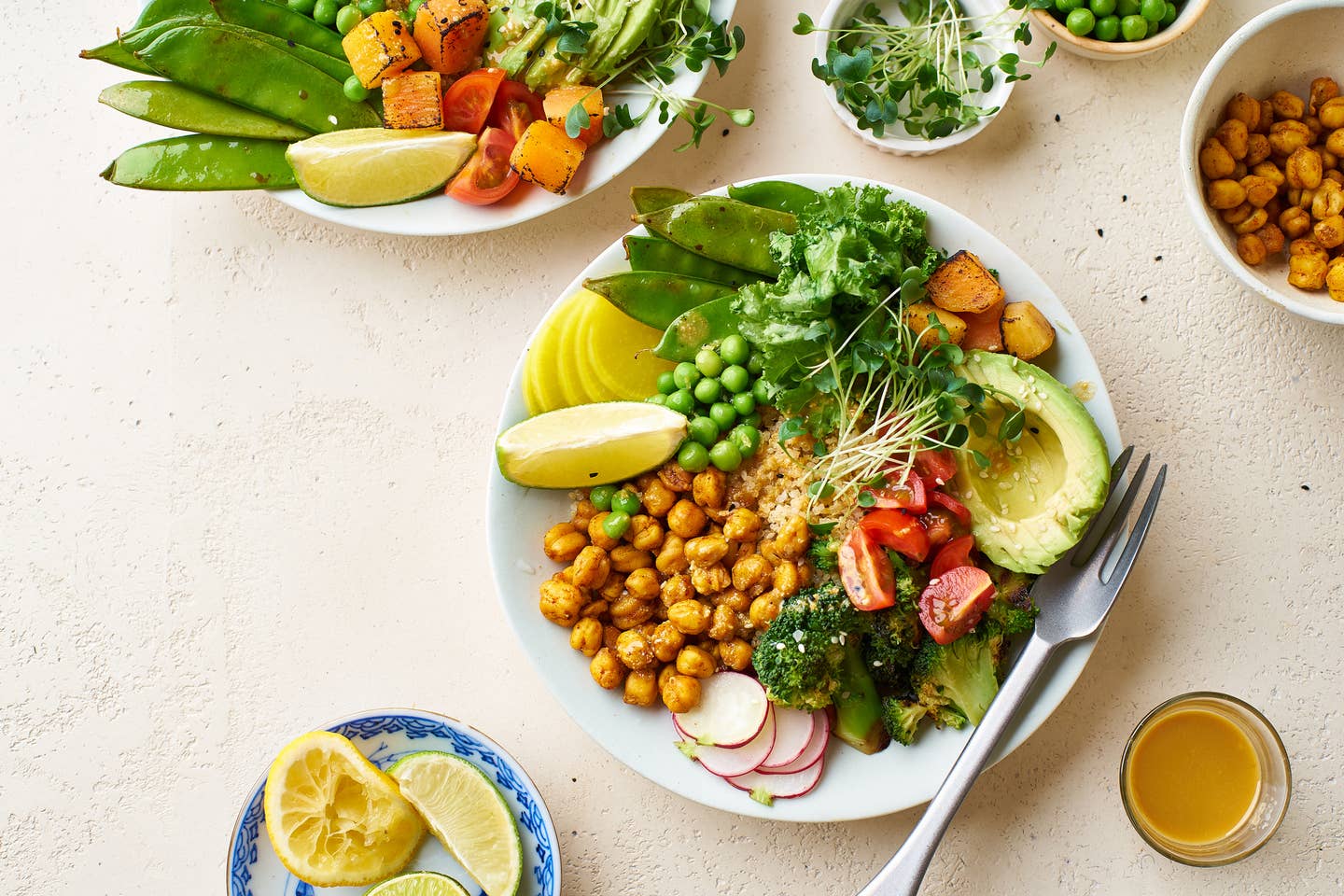
Five Ways Alcohol May Be Sabotaging Your Healthy Diet Efforts
Alcohol. Aka fun juice, liquid courage, or the sauce, could also be your healthy diet's saboteur. If a dry martini (or two) with 3 olives at the end of a stressful WFH day or a glass of Pino Noir (or several) is your go-to beverage for a (virtual) get together, your routine could be the reason your best diet efforts aren't working and you wake up exhausted. Modest intake of alcohol (one drink a day for women and two for men) will likely not cause too much harm. However, when consumed in excess, alcohol can interfere with sleep and sabotage our healthy diet efforts.
Drinking has become part of our coping mechanisms but the result can be nutrient deficiencies, weight gain, low energy, poor sleep, and an increased risk for chronic diseases, not to mention low energy the next day. Aren’t these all of the things you're trying to combat with a whole-food, plant-based diet? Let me explain how alcohol can be a sabotager!
1. Drinks Add Extra Calories Without Fullness
Alcohol provides calories, about 7 calories per gram. That translates to about 125 calories in a glass of red wine, or 170 in a Gin and Tonic, or 200 in a margarita on the rocks (or twice that in a frozen drink with a sugary mixer). However, unlike when we consume foods with other macronutrients (such as carbs, fats, and proteins), we don’t tend to reduce how much we eat as we drink a cocktail, to compensate for the energy that alcohol provides.
Although one standard drink of wine or beer has around the same amount of calories as a one-ounce serving of nuts or seeds (160 to 200) you will feel much fuller after the healthy nuts and seeds compared to the drink. In addition, these calories do not provide any of the beneficial nutrients from eating the same calories in foods that our bodies need to thrive.
2. Alcohol Depletes Certain Nutrients and Blocks Absorption
Alcohol in small doses can be an appetite stimulant, but in larger amounts, it can suppress normal hunger signals resulting in a reduction in the number of nutrient-rich foods being consumed. In addition, alcohol can affect nutrient absorption and utilization by the body, potentially leading to nutrient depletion and feeling low-energy, especially because some of the nutrients it blocks are essential, which defeats the purpose of eating a healthy diet.
As alcohol gets metabolized by the liver, it requires B vitamins (niacin, thiamine, etc.), which is why alcohol is particularly unhelpful when you're trying to feel more energy from the foods you eat. It also interferes with the absorption and storage of nutrients such as B12, folate, and Vitamin A. Certain minerals (such as zinc, magnesium, and potassium) can also be depleted through the urine, as alcohol has a diuretic effect and increases your urine output.
3. Shakes Up Our Brain Chemicals, So You Eat More
There is evidence to show that moderate consumption of alcohol before the meal can actually lead to an increase in our food intake. How? Well, we know that alcohol lowers our inhibitions and discipline, but it also stimulates a number of neurochemical and peripheral systems that are involved in appetite control–leading to overeating!
According to a recent study, alcohol has a stimulatory effect that leads us to eat more, while it suppresses fatty acid oxidation, meaning we burn less. In the brain, alcohol "stimulates a number of neurochemical and peripheral systems implicated in appetite control," the study says, so if you've ever had the "drunk munchies" it's because of the brain chemistry caused by alcohol.
One study indicated that just three drinks were enough to lower an appetite-regulating hormone responsible for satiety, called leptin, by about 30 percent.
It's a safe bet that when we are overeating after alcohol consumption, we are not likely to choose healthy foods like carrots and hummus but reach for the more indulgent foods like cookies, chips or ice cream. (As a Canadian, my weak spot is vegan poutine!) This just adds to the increase in calories that we consume when we have been overdoing it.
4. Booze Zaps Energy and Interferes With Sleep
Sure, we may be feeling energetic after our first drink of alcohol. However, alcohol actually has sedative and depressive effects that can interfere with sleep and make you feel fatigued.
Having a ‘night cap’ after dinner in the hopes that it will help you get to sleep can be counterproductive. Alcohol’s sedative effects may help you get to bed quickly, however, it can interfere with the quality of your sleep and interrupt your body's sleep cycles. Several hours after the ‘night cap’ alcohol causes a spike in epinephrine, a stress hormone that increases heart rate, resulting in us waking up with a startle throughout the night. Our energy will be zapped the next day after a restless nights’ sleep. This could lead to over-indulgent eating and sub-par, less nutrient-dense food choices.
You may also be craving high sodium foods after dehydration from alcohol as well. Safe to say you will want that vegan poutine now!
5. Increases Risk For Certain Health Conditions\
Modest drinking has been found to lower the risk of certain conditions, including heart attacks, diabetes, cardiovascular disease, and common types of stroke. However, there are certain health conditions that alcohol consumption can increase your risk of, including:
- Increased risk for certain cancers. Alcohol consumption has been linked to a higher risk of cancers. These include breast cancer, and cancer ofthe mouth, pharynx, larynx, esophagus, liver, colon, and rectum.
- Inflammation of the liver (alcohol hepatitis) and chronic liver injury can lead to cirrhosis, which is scarring of the liver. Every time you drink more than your liver can handle it has to recover, and if you do this day after day you create liver damage.
- Increased blood pressure and damage heart muscles. Excessive consumption has been linked to cardiomyopathy which is a weakening of the heart muscle. This shows after years of heavy drinking defined as more than four drinks a day or more than 14 drinks per week.
This is not meant to say that you can never consume alcohol–but rather to arm you with information about your choices. Drinking in moderation is the key! So think twice about mindlessly re-filling your glass of wine on a Tuesday while watching TV. It just might help you reach your health goals faster.
The Top 20 Veggies with the Most Protein
1. Soy Beans
Soybeans are a legume but they are such a great source of protein that we had to lead the veggie list with it. There is more protein in just one ounce of soybeans than a cup of sliced avocado! 1 cup equals Protein - 28.6g Calories - 298 Carbs - 17.1g Fiber - 10.3g Calcium - 175mg
2. Peas
If the pod, that peas are grown in, is split down the middle, that is an indicator they are ripe. Seeds inside the pod vary and can be green, white or yellow. 1 cup equals Protein - 8.6g Calories - 134 Carbs - 25g Fiber - 8.8g Calcium - 43.2 mg
3. Corn
Fresh corn is a great source of energy for those who like to stay active. Protein isn't all that corn has to offer. Corn provides the body with potassium and B vitamins. 1 cup equals Protein - 5.4g Calories - 177 Carbs - 123g Fiber - 4.6g Calcium - 4.9mg
4. Artichoke Hearts
Artichokes are part of the sunflower family. The fiber in artichoke hearts is great for supporting digestion. 1 cup equals Protein - 4.8g Calories - 89 Carbs - 20g Fiber - 14.4g Calcium - 35.2mg
5. Asparagus
If not properly stored, Asparagus tends to go bad quickly, To elongate freshness, put damp paper towels around the stems, or place the entire asparagus bunch in a cup of water (like flowers) to maintain freshness longer. 1 cup equals Protein - 4.4g Calories - 39.6 Carbs - 7.4g Fiber - 3.6g Calcium - 41.4mg
6. Brussel Sprouts
Brussel sprouts have more Vitamin C than an orange. If your Brussel sprouts have a rancid odor that is an indicator you overcooked them. The smell occurs because the sprouts are composed of a great amount of sulforaphane. 1 cup equals Protein - 4g Calories - 56.2 Carbs - 40g Fiber - 4g Calcium - 56.2mg
7. Broccoli
If you are trying to lose weight broccoli is a great addition to your diet because it consists of 90 water and is also high in fiber. 1 cup (chopped) equals Protein - 3.8g Calories - 54.6Carbs - 11.2g Fiber - 5.2g Calcium - 62.4mg
8. Mustard Greens
Mustard greens provide the body with tons of Vitamin A, Vitamin C, Vitamin K and fiber. Adding steamed mustard greens into your diet has been known to lower cholesterol and reduce inflammation. 1 cup equals Protein - 3.2 g Calories - 21 Carbs - 2.9g Fiber - 2.8g Calcium - 104mg
9. Avocado
Avocado is commonly mistaken as a vegetable but it is technically a fruit. This fruit had to be included in our veggie list because it isn't just tasty but super nutritious. Avocados are packed with protein but they are a great source of potassium and fiber. Avocados are a great addition to any salad, sandwich and even smoothie! 1 cup equals Protein - 3.0 g Calories - 240 Carbs - 12.8 g Fiber - 10.1g Calcium - 18 mg
Onions are an unappreciated food hero since they provide 20 percent of your daily Vitamin C and deliver an abundance of antioxidants that can reduce inflammation. 1 cup (chopped) equals Protein - 2.9g Calories - 92.4 Carbs - 21.3g Fiber - 2.9g Calcium - 46.2mg
11. Beets
The entire beetroot is edible including the leaves which contain loads of vitamin A, calcium, iron and potassium. Beetroot is high in sugar but is considered one of the most nutritious veggies used in salads and soups. 1 cup equals Protein - 2.8 g Calories - 74.8 Carbs - 17g Fiber - 3.4g Calcium - 27.2mg
12. Oyster Mushrooms
Oyster mushrooms are commonly seen in Chinese dishes. They grow best in a controlled environment indoors. Oyster mushrooms have so many nutrients to offer besides protein such as iron, calcium, zinc and folic acid. 1 cup (raw and sliced) equals Protein - 2.8g Calories - 37 Carbs - 5.6g Fiber - 2.0g Calcium - 2.6mg
13. Bok Choy
Bok Choy is a member of the mustard family. One of the oldest cultivated vegetables in the world, Bok Choy means "white vegetable” and is a great source of vitamins A, C, B6, K, and E, magnesium, potassium, iron, manganese, and calcium. 1 cup equals Protein - 2.7 g Calories - 20.4 Carbs - 3.1g Fiber - 1.7g Calcium - 158mg
14. Green Beans
Green beans are a great source of vitamins B, C and K, and minerals such as magnesium, iron and manganese. Green beans should be cooked before eating, to destroy lectins. China is the biggest grower of green beans in the world, exporting over 15 million tons a year. 1 cup equals Protein - 1.8 g Calories - 31 Carbs - 7 g Fiber - 2.7 g Calcium - 37 mg
15. Cauliflower
The most nutritious way to consume cauliflower is steamed. Don't get intimidated by orange, purple or green cauliflower. All three types have the same benefits as white cauliflower. 1 cup equals Protein - 2.2g Calories - 28.6 Carbs - 5.4g Fiber - 2.8g Calcium - 19.8mg
16. Turnip
You can eat the entire plant, root and leaves. The turnip root is high in vitamin C and the greens are high in vitamins A, C, E, B6 and K, believed to counter inflammation. Add turnip roots to soup, or mash them. Add them to salads. 1 cup equals Protein - 1.6g Calories - 28.8 Carbs - 6.3g Fiber - 5.0g Calcium - 197mg
17. Alfalfa Sprouts
Alfalfa sprouts might be little but they sure are powerful. Plus they're quick and easy to grow. They are loaded with Vitamin C, Vitamin K, Iron and more. But because they have been known to carry bacteria, make sure to fully cook alfalfa sprouts if you have a fragile immune system or are pregnant. 1 cup equals Protein - 1.3 g Calories - 8 Carbs - 0.7 g Fiber - 0.6 g Calcium - 10.6 mg
18. Tomatoes
Keep your tomatoes fresher for longer by storing them stem down. When exposed to sunlight the Vitamin C in a tomato will diminish. 1 cup equals Protein - 1.3g Calories - 26.8 Carbs - 5.8g Fiber - 1.8g Calcium - 14.9mg
19. Zucchini
Zucchini has an abundance of potassium, even more than a banana! The reason zucchini isn't high in calories is that it is made up of 95% water. 1 cup equals Protein - 1.2g Calories - 28.8 Carbs - 7.1g Fiber - 2.5g Calcium - 23.4 mg
20. Spinach
Spinach is filled with Vitamin A, Vitamin E, Vitamin K, fiber and protein. The best part about spinach is you can sauté it, blend it or eat it raw! Spinach is best grown in rainy and cool weather. 1 cup equals Protein - 0.9g Calories - 6.4 Carbs - 1.0 g Fiber - 0.6g Calcium - 27.7 mg
More From The Beet






